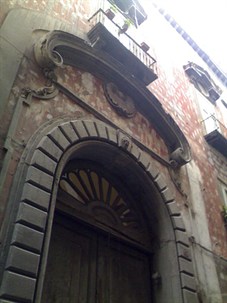Conquering the capital: the urban palace of Naples
The political affirmation of the Acquaviva family, which, in the sixteenth century entered the orbit of the great nobles of the kingdom and, consequently, was swallowed up by the court which gravitated around the resident Spanish viceroy in Naples, gradually shifted the centre of gravity from the political fiefs to the capital. Here the family joined the Neapolitan nobility in the municipal parliament as part of the Seggio di NidoThe Neapolitan nobility was divided into the five squares of quarters or seats in the civil parliament during the early modern age: Capuana, Montagna, Nido, Portanova and Porto. The representatives of the five squares together with a representative of the people, formed the Tribunale di San Lorenzo (Tribunal of St. Lawrence), which ruled the city. in 1505, resulting in the need for them to reside more frequently in Naples, where the great aristocracy of the kingdom began to build stately homes, real status symbols, prestige, wealth of power.
 The palace of the Dukes of Atri is located in Via D’Atri. In 1470 Giulio Antonio Acquaviva, at the height of his military and political career, acquired the important palace in Naples that the king had given to Galzerano Requesenz, the general admiral of the fleet. The impressive building, which began to be heavily altered by the new owners to fit the needs of the powerful family, is one of the few cases in Naples of a noble residence which remained in the hands of the same family, at least until its extinction in the eighteenth century. The first major renovation of 1509-1514 was started by Andrea Acquaviva who, it seems, commissioned the work to the most important architect of the time, MormandoGiovanni Francesco Mormando (1449-1530) was an Italian architect and builder, active mainly in Naples., but little remains of these interventions today. It is interesting to note, however, that the original building was located in a rather narrow area, which did not allow for any extension of the building. This trick followed by Acquaviva was similar to that adopted by other noble families: the purchase and ownership of other houses close to the main building allowed them, in fact, to proceed with subsequent mergers, to take over the entire street, which today bears their name. Even so, however, the building lacks an organic order, probably due to the absence of the skillful hand of some master architect, especially between the sixteenth and seventeenth centuries. The interventions of the eighteenth century, attributed to Giuseppe Astarita, which gave a Baroque appearance of the building, were the most valuable and consistent. The palace became an important centre for cultural encounters in the sixteenth and seventeenth centuries, for famous writers such as Giovanni PontanoGiovanni Pontano (1429-1503) was the chief representative of fifteenth century Neapolitan humanism and the Accademia Pontaniana. Among his works, we recall the Amorum libri, Hendecasyllabi, De amore congiugali, Tumuli, Neniae and De hortis Esperidum. and Jacopo SannazaroJacopo Sannazaro (1457-1530) was an Italian humanist and poet, an author of works both in Latin and in the vernacular. His main work is undoubtedly the pastoral romance in prose and verse the Arcadia, a source of inspiration for the academy with the same name, founded in the late seventeenth century in Rome., Acquaviva’s protégés, whose works, not coincidently, were printed in the printing house of the Dukes of Atri.
The palace of the Dukes of Atri is located in Via D’Atri. In 1470 Giulio Antonio Acquaviva, at the height of his military and political career, acquired the important palace in Naples that the king had given to Galzerano Requesenz, the general admiral of the fleet. The impressive building, which began to be heavily altered by the new owners to fit the needs of the powerful family, is one of the few cases in Naples of a noble residence which remained in the hands of the same family, at least until its extinction in the eighteenth century. The first major renovation of 1509-1514 was started by Andrea Acquaviva who, it seems, commissioned the work to the most important architect of the time, MormandoGiovanni Francesco Mormando (1449-1530) was an Italian architect and builder, active mainly in Naples., but little remains of these interventions today. It is interesting to note, however, that the original building was located in a rather narrow area, which did not allow for any extension of the building. This trick followed by Acquaviva was similar to that adopted by other noble families: the purchase and ownership of other houses close to the main building allowed them, in fact, to proceed with subsequent mergers, to take over the entire street, which today bears their name. Even so, however, the building lacks an organic order, probably due to the absence of the skillful hand of some master architect, especially between the sixteenth and seventeenth centuries. The interventions of the eighteenth century, attributed to Giuseppe Astarita, which gave a Baroque appearance of the building, were the most valuable and consistent. The palace became an important centre for cultural encounters in the sixteenth and seventeenth centuries, for famous writers such as Giovanni PontanoGiovanni Pontano (1429-1503) was the chief representative of fifteenth century Neapolitan humanism and the Accademia Pontaniana. Among his works, we recall the Amorum libri, Hendecasyllabi, De amore congiugali, Tumuli, Neniae and De hortis Esperidum. and Jacopo SannazaroJacopo Sannazaro (1457-1530) was an Italian humanist and poet, an author of works both in Latin and in the vernacular. His main work is undoubtedly the pastoral romance in prose and verse the Arcadia, a source of inspiration for the academy with the same name, founded in the late seventeenth century in Rome., Acquaviva’s protégés, whose works, not coincidently, were printed in the printing house of the Dukes of Atri.
